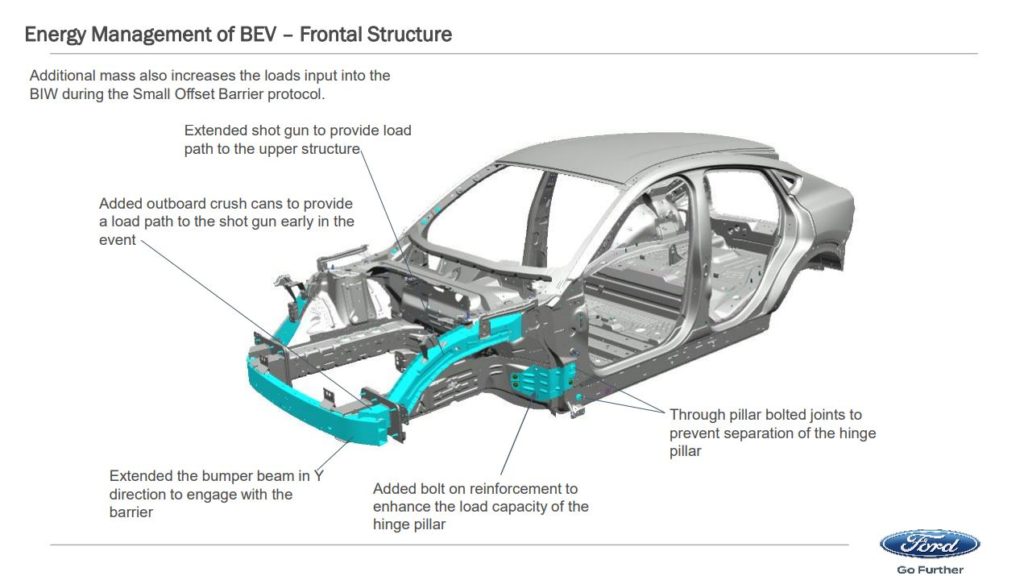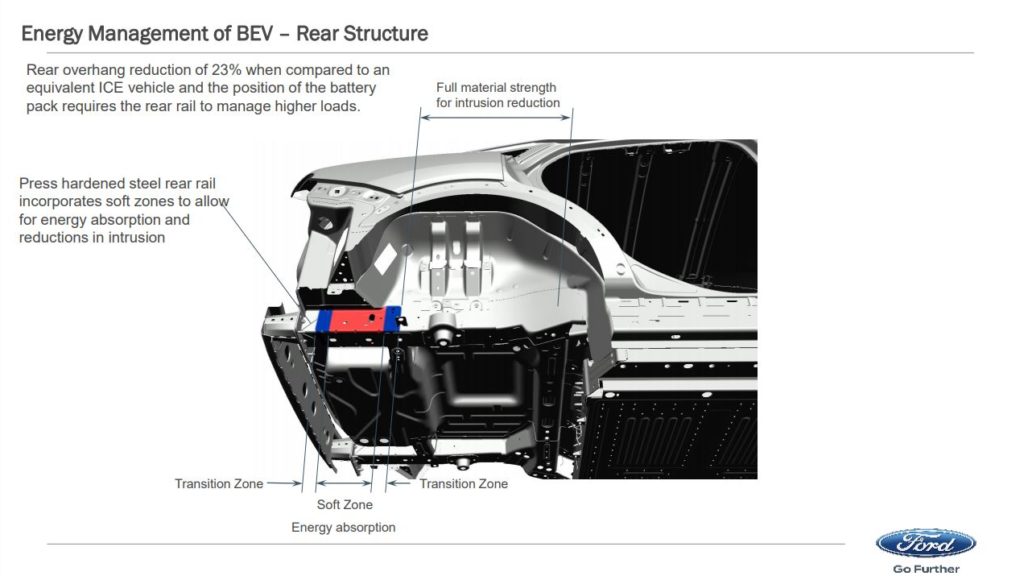
Ford describes reworking crash protection to accommodate 2021 Mustang Mach-E battery
By onAssociations | Business Practices | Market Trends | Repair Operations | Technology
A recent Ford presentation on how it adjusted structural crash protection for the 2021 Mustang Mach-E’s fully electric powertrain provides collision repairers with a sense of changes they might see on other vehicle bodies.
Unlike a traditional internal combustion engine powertrain, the gigantic battery at the heart of a fully-electric vehicle is often housed beneath the floor, between the rockers. It’s a heavy, expensive part that while normally perfectly safe can pose a risk to the occupants and/or if damaged in a serious crash. So you’ve got to protect it as well as the humans above it.
Ford vehicle hardware modules integration chief engineer Mark Mikolaiczik explained to the May 19 Great Designs in Steel how his OEM addressed this problem on the 2021 Mach-E.
“We faced many challenges related to energy management as we moved from the ICE to the BEV,” Mikolaiczik said.
Mikolaiczik said shifting from a gas to electric powertrain meant Ford had to deal with a 36 percent increase in test mass and energy input during a crash.
“That’s primarily due to the weight of the battery,” he said.
But Ford also faced a 10 percent reduction in the crush space available in the front of the vehicle compared to a gas vehicle.
This meant the front rails had to handle a 53 percent increase in crash load, he said.
“We increased the rail section,” Mikolaiczik said. He said the OEM boosted the front rail gauges to 1.9 mm and strengthened the upper load path (the shotgun to the hinge pillar).
He said Ford also made sure the vehicle had no “stress risers” related to tire clearances.
Normally, Ford would send frontal crash energy through the front rails and into the torque box and sled runners.
“We did not have that luxury due to the package of the battery pack,” Mikolaiczik said. “… We had to change our load path strategy.”
Instead, Ford had to rely solely on the torque box and send energy into the rockers, Mikolaiczik said. This meant Ford needed a “very robust dash crossmember” to manage the rails’ compressive loads and the powertrain’s bending loads.
“We did a tremendous amount of work” incorporating the battery into the structure, he said.
Originally, Ford sought a rectangular battery for maximum energy density, according to Mikolaiczik. But this meant the torque box would need 90-degree square corners to handle the crash energy, which meant “high mass and cost.”
Mikolaiczik said Ford concluded, “‘Well, we know that’s not gonna work.’ … ‘We gotta make changes.'”
The OEM instead chamfered the front of the pack, allowing the torque box to have a “smoother transition” between the front rails and the rocker panels and boosting structural efficiency.
Moving up through the floor, repairers will find a lateral crossmember Mikolaiczik said Ford installed to help handle the compressive load. He described it as a balance between giving customers as flat a floor as possible but handling severe loads from a crash.
According to a Ford slide, the extra vehicle mass meant more energy reached the body in white during the IIHS’ small-overlap crash test. The test bangs the outer 25 percent of the vehicle’s front end into a barrier at 40 mph.
Ford extended the shotgun to send the load to the upper structure and added crush cans to get the crash energy to the shotgun sooner, according to Mikolaiczike. It also extended the aluminum bumper beam “to engage the barrier” and bolted on a reinforcement to toughen the hinge pillar, he said. Through-bolted joints also kept the hinge pillar from separating, he said.
“That all worked fantastically,” Mikolaiczik said.
Side-impact crashes with the battery-electric Mach-E presented a challenge to Ford as well, Mikolaiczik said.
In an internal combustion engine vehicle, you just need to keep the crash forces away from the occupants. But in a skateboard electric vehicle like the Mach-E, the battery needs to be protected as well. Mikolaiczik said Ford needed to absorb the crash energy before intrusion into the battery case occurred.
He said the OEM lost its available crush space “by a factor of 2” compared to an ICE vehicle.
In addition, the battery’s mass meant the collision between the vehicle and side-impact test pole now carried a load of 350 kiloNewtons, he said.
So Ford decided to beef up the floorpan, according to Mikolaiczik. A Ford slide described press-hardened steel side sills and crossmembers and Martensitic roll-formed rockers.
Mikolaiczik described the rocker as a three-piece Martensitic roll-formed setup with steel strengths ranging from 1,500-1,700 MPa. He said this permitted smaller sections. A slide described the overall structure as “Tuned to Handle BEV Loads.”
Through-bolts unite components to achieve a “solid node” for the IIHS’ small-overlap crash test, according to Mikolaiczik.
According to the slide, the rocker extends to the leading edge of the hinge pillar to engage with the small-overlap collision early, and Mikolaiczik said this allowed Ford to “rigidize” backup structure for that crash energy.
The rockers were designed for both side-impact and small-overlap crashes, according to Mikolaiczik. He said the ultimate design saved $50 per vehicle compared to the company’s early plans, which the slide suggested might have been extruded aluminum.
The slide said that using the multiple steel parts let Ford use traditional welding techniques but still accommodate the bolt-on battery tray and optimize energy path.
The three-piece design allows “B-pillar pass-through,” and the split geometry collapses together in side impacts to “maximize energy absorption,” Mikolaiczik said.
The back of the crossover featured “clever energy management,” according to Mikolaiczik.
The electric crossover presented Ford with a 23 percent rear overhang reduction (i.e., less room to deal with the energy of getting rear-ended) compared to a gas model, Mikolaiczik said. The battery’s location also meant the rear rails would need to handle higher loads.
Mikolaiczik said Ford built its rear rails out of press hardened steel “with a soft zone.” The area behind the battery pack was “fantastic for absorbing energy” and was followed by a stiffer region.
Thus, both the occupants and battery are protected, he said.
Ford’s work paid off. The 2021 Mustang Mach-E is an IIHS Top Safety Pick, and it scored “good” ratings on all the IIHS’ crash tests. It hasn’t yet received ratings from NHTSA, whose testing includes a side-impact pole strike not featured in the IIHS’ regimen.
More information:
Ford at Great Designs in Steel, May 19, 2021
Ford at Great Designs in Steel, May 19, 2021
Official Ford OEM repair procedures
Images:
The 2021 Mustang Mach-E undergoes the Insurance Institute for Highway Safety small-overlap crash test. (Provided by IIHS)
Normally, Ford would send frontal crash energy through the front rails and into the torque box and sled runners of an internal combustion engine vehicle. (Ford slide provided by Great Designs in Steel)
Ford originally sought a rectangular 2021 Mustang Mach-E battery for maximum energy density. But this meant the torque box would need 90-degree square corners to handle the crash energy. Ford reworked the design. The OEM instead chamfered the front of the pack and allowed an easier transtion between the front rails and the rocker panels and boosting structural efficiency. (Ford slide provided by Great Designs in Steel)
Ford modifications to help the battery-electric 2021 Ford Mustang Mach-E handle the IIHS small-overlap crash test. (Ford slide provided by Great Designs in Steel)
Ford decided to beef up the floorpan to handle side-impact crashes to the fully electric 2021 Mustang Mach-E. A Ford slide described press-hardened steel side sills and crossmembers and Martensitic roll-formed rockers. (Ford slide provided by Great Designs in Steel)
The 2021 Ford Mustang Mach-E rocker includes a three-piece Martensitic roll-formed setup with steel strengths ranging from 1,500-1,700 MPa. (Ford slide provided by Great Designs in Steel)
The fully electric 2021 Mustang Mach-E presented Ford with a 23 percent rear overhang reduction compared to a gas model. The battery’s location also meant the rear rails would need to handle higher loads. (Ford slide provided by Great Designs in Steel)






